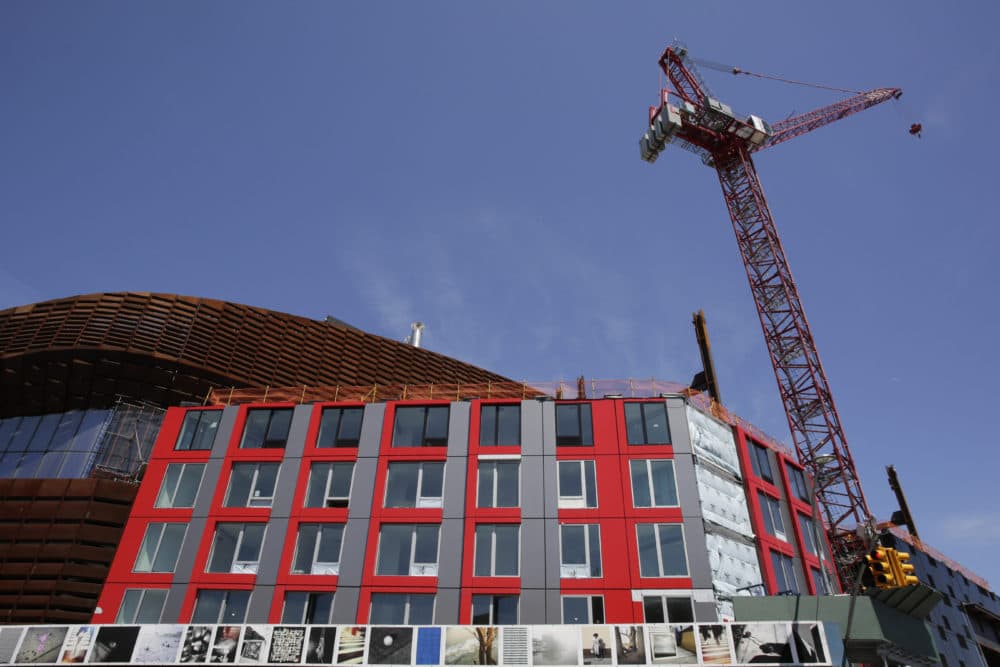Advertisement
Factory-Made Homes Grow More Popular As U.S. Cities Face Housing Crunch
Resume
The cost of building a home in the U.S. is rising as many cities face a construction labor shortage. In the hopes of shrinking the construction timeline, some home builders are turning to prefabricated units. Modular construction, as its known, is a small but growing segment of the market for single-family homes, apartment buildings and even hotels.
“The thing that needs to be thought about is the very tight metro markets can cause some logistics issues,” says John Erb, director of construction at Champion Commercial Structures, a modular construction company based in Williamsport, Pennsylvania. “Those 70-foot-long modules may not be able to be that big, but from a speed perspective, it's absolutely a way to consider.”
In an urban setting, modular construction can cut a normal construction timeline down 25 to 30 percent, according to Erb. In a suburban area, it can knock the time frame down even more, by close to 45 percent.
And although the prefabricated units are quick to make, that doesn’t necessarily mean they are cheap in quality, Erb tells Here & Now’s Peter O’Dowd.
“It is what the perception has been for years,” Erb says. “But any person that comes and walks one of our projects walks away with a whole different mindset.”
Interview Highlights
On how the modular construction process works
“At our factories — and we have two of those in Pennsylvania right now and a third one that will be opening up in Indiana in the spring of 2019 — we manufacture three-dimensional, volumetric modules that come out to the project site and get erected on top of each other and on top of a foundation or a podium component to make up the entire building structure.
“When you think of a hotel as an example, a typical module is going to be two hotel suites and the corridor in the middle. So it could be a 60-plus or a 70-some-foot-long module that contains two king-sized suites and that corridor component.
“The skin goes on on the project site just like it would in any conventional building. The final roof gets put on on site. But the modules come out so that the suites are virtually finished. So the tile and bath, all the plumbing fixtures and bathroom components are installed. The ceramic tile in the bathroom's installed. The carpeting or the flooring in the suite sleeping area's installed. The wallpaper is on the walls, and the walls are painted. In theory, those modules are very, very complete when the boxes are erected at the job site.”
"My home is a modular home. [It's] like my neighbor's house, but a little bit bigger and a little bit sturdier."
John Erb
On how the labor costs are cheaper than normal construction
“All of the portion of the job that's built offsite in a manufacturing facility is generally built at a non-union labor rate. So when you're looking at high-union markets, there's where some potential dollar savings can come into play.”
On the criticism that modular construction will create cities with buildings that look the same
“The funny part is, we would love as manufacturers to build cookie-cutter [buildings]. The unfortunate part is most of our projects we find become more custom every time, so that part goes away. The thing to think about, though, is the aesthetics of the building, the outside skin … the overall design is what creates the character of the building, and that can make things look different. And generally that skin part goes on on the job side anyway, so then at least the appearance of the project is going to help with the city environment.”
On where he sees the modular construction industry heading
“We're not sure where it's going to go yet. The question's just going to come down to the capacity of the manufacturers that are out there and the risk level, if you will, that each of those manufacturers wants to get into with certain-type projects.”
On how his house was prefabricated
“My home is a modular home. [It's] like my neighbor's house, but a little bit bigger and a little bit sturdier.”
Chris Bentley produced and edited this interview for broadcast. Jackson Cote adapted it for the web.
This segment aired on December 26, 2018.
